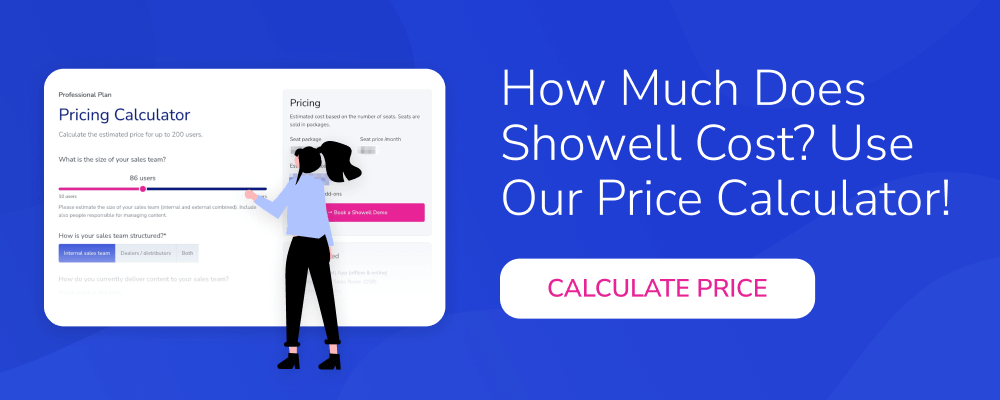Sales enablement content is the unsung hero in sales. It’s the secret sauce that arms your sales team with the knowledge and resources to move deals through all stages effectively, engaging all stakeholders involved.
Sales enablement content helps to ensure that your sales team is armed with the right messages and materials to effectively engage prospects and customers and to move deals forward. So let's delve further into sales enablement content and how you can use it to maximum advantage.
What you'll find in this blog:
What is Sales Enablement Content?
Sales enablement content comprises various materials designed to boost the efficiency and productivity of your sales force. It includes anything from product brochures to case studies, all geared towards one thing: to help your sales team close more deals and engage with prospects.
These materials can be divided into two main categories:
- Customer-Facing Sales Content: This external content is used by your salespeople to engage prospects and customers, including product brochures, value presentations, requirement surveys, case studies, and demonstration videos.
- Internal Learning and Training Content: Internal content is designed for your sales team's learning and development, covering sales campaign instructions, sales playbooks, sales argumentation guides, do's and don'ts tips, and pricing guides.
Three Key Functions of Modern Sales Enablement Content
According to Gartner, the modern sales enablement process is built around three main functions:
1. Shift the focus from helping sellers to sell to guiding sellers to help buyers buy. Buyers want to be educated, not sold to.
2. Build customer confidence (buyers who experience high confidence are nearly 10X more likely to buy).
3. Enable multithreaded buying in a digital environment consisting of multiple different touch points and stakeholders across the buying process.
Ownership and Responsibility of Sales Enablement Content
Sales enablement content often falls under the marketing team or a dedicated sales enablement team. Key roles responsible for content include sales managers, product marketers, or even dedicated sales enablement professionals. These roles involve creating, curating, managing, and distributing sales enablement content.
A Sales Enablement Manager, ideally, oversees the overall process. This role may have a more managerial or hands-on approach, depending on the company's size and complexity.
As Sales Enablement Pro notes, a sales enablement manager is "responsible for deploying programs and initiatives that enable customer-facing teams to execute the core aspects of their jobs more effectively, especially as it relates to selling and revenue performance."
The Value of Sales Enablement Content for Sales Teams
Sales enablement content bridges the gap between seller and buyer, offering clarity amid the torrent of information buyers face. High-quality, targeted, and well-utilized content accelerates deals and leads to quicker closures.
Salesforce research reveals that 58% of pipelines stall because sales reps are unable to add value to buyers. Hence, without the right information conveyed effectively, the sales process can falter.
In a world where "57% of B2B buyers find the materials shared by vendors to be useless" and "60% of buyers get information from other sources than the sales rep" (Forrester), it's critical that your sales enablement content be informative, relevant, and valuable. It prepares your sales team to navigate the complexity that "77% of buyers find purchasing increasingly complex and difficult" (Gartner).
7 Types of Sales Enablement Content You Need
Sales enablement content isn't just about information overload. It's about empowering your reps to have winning conversations with prospects. These 7 content types will transform your sales force from product presenters to conversation champions, equipped to build trust, showcase value, and close more deals.
1. Learning and Training Materials
Empower your sales team with knowledge about your products, industry trends, and effective selling techniques. Examples include sales playbooks, and competitor research and analysis materials.
2. Company Presentations: Story, Background, Expertise, and Experience
Building trust and credibility starts with presenting your company’s story. Include a detailed history, mission, vision, and values. Also, incorporate a list of current customers and their logos to display your market footprint.
Remember that the story is the most important part of your company presentation.
|
💡Tip: keep the presentation short and make it visual. Some experts suggest using the 5/5/5 rule:
|
3. Requirement and Pain Point Assessment Materials
To solve your prospect's problems, you need to identify them first. Utilize materials like ROI calculators and product comparison charts to help you understand the customer's needs better.
|
💡 Example of an ROI Calculator: Consider a waste management machinery company. Their ROI calculator could include:
The ROI is calculated as follows: [(Total Savings - Total Costs) / Total Costs] x 100% In this example, first-year costs are $162,000, and savings are $120,000, yielding a first-year ROI of -25.9%. However, ROI becomes positive in the second year and beyond, demonstrating financial and environmental benefits. |
Identifying your customer needs, at its core, seeks to answer the fundamental question of "What does the client truly need to achieve their business objectives?" To know more about this process, learn more about Customer Needs Analysis: Converting Challenges into Solutions.
4. Benefits and Value Presentations
Crafting a powerful sales presentation starts with understanding your audience. By knowing who you're presenting to, you can tailor your content and messaging to address their unique pain points, sparking genuine interest and engagement.
With that in mind, create presentations that focus on the benefits and value of your solution for the customer. These can be standalone presentations (e.g. PowerPoint slides) or integrated into product brochures or one-pagers. Once you’re a bit further in the sales journey, consider creating a sales proposal and a personalized solution video walkthrough.
|
💡 Tip: Utilizing 3D configurators can significantly enhance value presentations. By allowing real-time, interactive customization and visualization, they help clearly demonstrate the value and functionality of products. This approach enables prospective customers to explore and understand the product on a deeper level, ultimately aiding in effective value communication. Discover more about 3D configurators and their impact on customer engagement in this comprehensive article The Ultimate Guide to 3D Configurators by VividWorks. |
5. Product Presentations, Explainer Videos, and Technical Information
Your salespeople need to answer any specific questions that a customer may have. Create product presentations, explainer videos, product cheat sheets (spec doc), security and privacy materials, and certificates that detail specific features, technical details, installation procedures, and more.
6. Testimonials and Case Studies
These increase trust and credibility, showcasing your current customers' experiences and the benefits they've received. Consider creating video testimonials for added authenticity.
A good case study is made of 3 main elements: the problem, the solution, and a summary of the outcome that your solution brought. That structure is used for example in this customer success story: How Sakura Boosted Their Sales Content Management by 10X?
Consider creating case studies and testimonials for presenting and sharing. You can have the same story in two formats: short and long. Short is for presenting and longer is used when you want to share the story with your audience.
|
💡 Growth agency Prami suggests including at least the following in your reference:
|
7. Pricing
Clear and transparent pricing can significantly influence the decision-making process. Provide pricing guidelines that not only state the costs but also justify the price based on value.
How to Manage, Organize and Deliver Sales Enablement Content
Managing and delivering sales enablement content is as crucial as creating it. Consider using a sales enablement platform to centralize all your content. This way, your sales team can quickly find what they need when they need it.
Furthermore, make your content easy to digest. Use visuals, infographics, and videos whenever possible. Remember, quality trumps quantity. Each piece of content should serve a specific purpose and add value to both your sales team and prospects.
Lastly, ensure your content remains updated. Regularly review and revise the content based on new product features, market trends, or customer feedback.
How To Structure Your Sales Enablement Content
In this example sales content structure, each category has a specific purpose, and by categorizing content this way, your sales team can easily navigate and find the exact material they need for a specific sales situation.
| Category | Description | Content Examples |
| Company | Generic company presentation materials (e.g.story, history, mission, vision, etc.), customer references, and testimonials |
|
| Solution |
Solution overview content which helps to identify and assess buyer’s needs and pain points and target your solution’s benefits and value to those |
|
| Product | More technical information about product/products |
|
| Delivery | Materials that explain how you deliver, install, and support your solution |
|
| Academy | Materials used for learning and training (internal use only) |
|
In conclusion, a comprehensive sales enablement strategy isn't complete without content that is purposeful, customer-centric, and easy to digest. If 20% of your top performers bring in 80% of sales, imagine the possibilities if the remaining 80% could perform just half as well. The key lies in equipping them with the right sales enablement content.
Take this opportunity to let your sales enablement content do what it does best with Showell. Book a demo by clicking the banner below or Get Showell Free and transform how you deliver and manage your content.
Time to get creating, curating, and managing!
Learn next:






